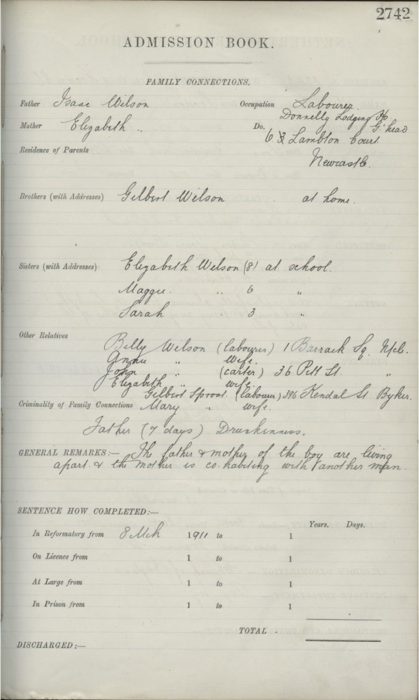Admission register entry for Isaac Wilson, 1910
Reference: NRO 00820/B/10 p. 2742(A, B)
Suggested age groups: KS2, KS3, KS4, lifelong learners
Subject areas: History, Literacy, Geography
CONTEXT
At the beginning of the nineteenth century a child who committed a crime was tried in the same court as an adult. If the judge or magistrate sentenced them to prison, they would be sent to the same prison as adult criminals.
Some campaigners, such as Mary Carpenter, argued that children should be kept away from adult criminals so that they did not learn bad habits from them. She also said that children should be given training and be allowed to play.
Pressure from campaigners led to Parliament passing the Reformatory Schools Act in 1854. The Act allowed reformatory schools to be set up and for them to be officially inspected. Magistrates could send children under the age of 16 to these schools, instead of to prison.
A reformatory school was set up in Newcastle in 1853, just before the Act passed through Parliament. The school was moved to Netherton, near Morpeth, in 1857. In 1933 Netherton became an “Approved School”, which replaced reformatories and industrial schools. Netherton continued to be a residential school for boys well into the 1980s.
A page like this was filled out by the staff at Netherton when a new boy arrived at the school. It includes a lot of information about him, his family and why he had been sent to Netherton.
The top of the first page (A) includes personal information, such as name, age (15 years 9 months) and physical appearance.
The middle of the first page (“OFFENCE”) includes the details of his crime: stealing six pairs of boots.
At the top of the second page (B) is a list of Isaacs’s family members. Isaac’s father is recorded as living in Gateshead and his mother in Newcastle. Further down the page (GENERAL REMARKS) includes the information that “…the mother is co-habiting [living] with another man”. At this date divorce was still rare; it was an expensive process that most ordinary people could not afford.
It is also noted on this page (Criminality of Family Connections) that Isaac’s father had served seven days in prison for “drunkenness”.
ACTIVITIES
ACTIVITY 1
Background
Isaac Wilson arrived at Netherton in 1910, aged 15 and 9 months. He was sentenced to stay there until he was 19 for the crime of stealing boots.
SEE
See: How old was Isaac Wilson when he arrived at Netherton?
See: How long was Isaac’s sentence at Netherton?
See: What crime did Isaac commit?
See: What crimes had Isaac committed previously?
See: Where did Isaac live before he was sent to Netherton?
THINK
Think: What can you learn about Isaac’s family life from the register?
Think: Think about how Isaac is described in the register entry. Using what you have learned about reform school, do you think he would have returned to crime after he completed his sentence?
DO
Do: Use Google Maps to find Isaac’s family home. Do you think the street has changed a lot since Isaac lived there? What can you learn about Isaac’s circumstances by looking at where he lived?
Do: Research some of the main reasons crimes were committed during this time period. How does Isaac’s crime fit with the crime trend of the time?
Do: How might Isaac have felt about going to Netherton? Write a list of the positive and negative points of being sent to reform school. Consider what the boys have access to at Netherton, what the living conditions were like there, and how this differs from their home life and personal circumstances.
Do: Write a monologue as though you are Isaac and have just arrived at Netherton. Describe what you are feeling and thinking about spending the next few years at Netherton away from your family home. You could use your list of positive and negative points to help you write the monologue.
Resources
ACTIVITY 2
Background
At the beginning of the nineteenth century a child who committed a crime was tried in the same court as an adult. If the judge or magistrate sentenced them to prison, they would be sent to the same prison as adult criminals. Pressure from campaigners led to Parliament passing the Reformatory Schools Act in 1854. The Act allowed reformatory schools to be set up and for them to be officially inspected. Magistrates could send children under the age of 16 to these schools, instead of to prison.
SEE
See: How were child criminals tried and sentenced in the early nineteenth century?
See: Why did campaigners want to keep child criminals separate from adult criminals?
See: What did Mary Carpenter say children should be given, rather than being sent to prison with adults?
See: When was the Reformatory Schools Act passed?
See: Who could be sent to reformatory school?
THINK
Think: What were Mary Carpenter’s education principles and methods?
Think: How were Mary Carpenter’s education principles and methods different to the general principles of the time?
Think: What was the purpose of reformatory school?
Think: What were the conditions like in reformatory school?
Think: What were the rules and regulations of reformatory school?
Think: What would the children have spent their time doing at reformatory school?
DO
Do: In small groups, debate whether or not introducing reformatory schools was the right way to punish child criminals.
Do: Using the information provided by the Children’s Homes website, draw up a plan of Netherton.
Resources
OTHER ONLINE RESOURCES
The National Archives website, page on “Victorian Children in Trouble”: https://www.nationalarchives.gov.uk/education/resources/victorian-children-in-trouble/
Infed.org website, page about Mary Carpenter and her ideas about education:
https://infed.org/mobi/mary-carpenter-reformatory-schools-and-education/
Northumberland Archives blog, page about Netherton Reformatory:
https://northumberlandarchives.com/test/2015/03/30/netherton-reformatory-one-mans-first-world-war-story-david-eckstein/
Children’s Homes website, page with history of Netherton Reformatory:
http://childrenshomes.org.uk/NethertonRfy/
Children’s Homes website, page with general information about reformatories: http://childrenshomes.org.uk/Rfy/
Children’s Homes website, page with model rules and regulations (1890): http://childrenshomes.org.uk/rules/Rfy.shtml


